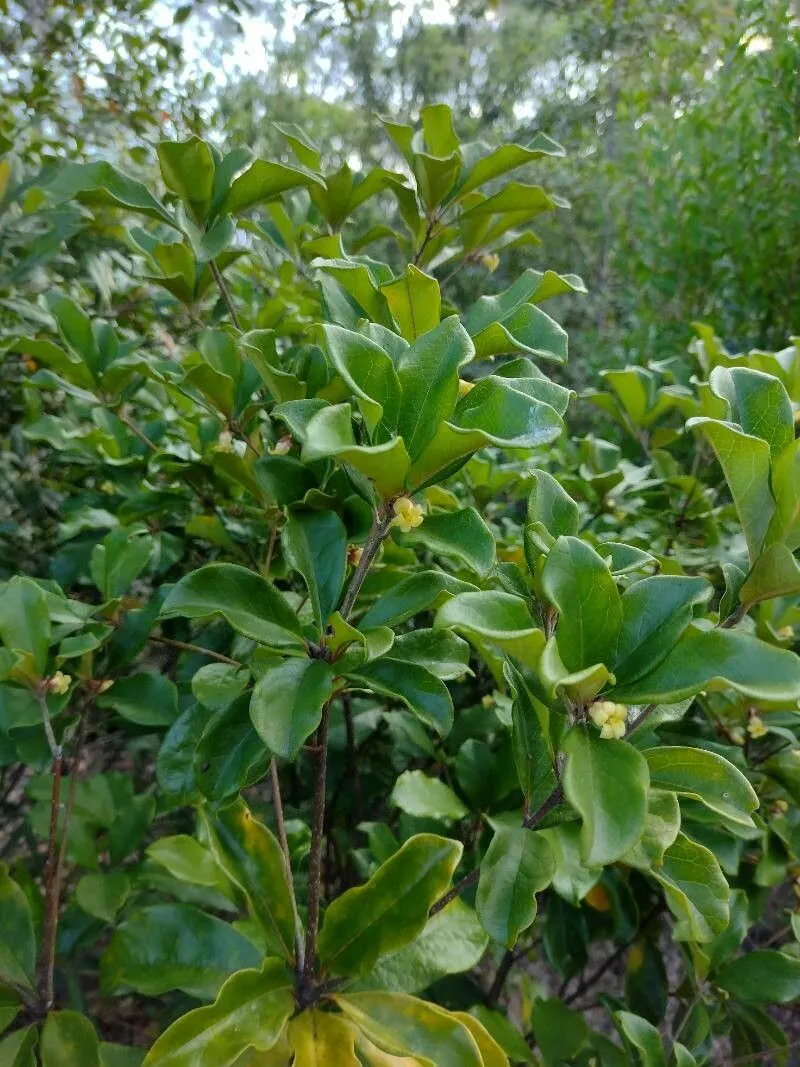
Author: W.T.Aiton
Bibliography: Hortus Kew. 2: 27 (1811)
Year: 1811
Status: accepted
Rank: species
Genus: Pittosporum
Vegetable: False
Observations: E. Queensland to E. Victoria
The Brisbane-laurel, scientifically known as Pittosporum revolutum, is an evergreen shrub that belongs to the Pittosporaceae family. This species was first documented in literature by W.T. Aiton in “Hortus Kewensis,” published in 1811.
Pittosporum revolutum is native to the eastern regions of Australia, specifically from Eastern Queensland to Eastern Victoria. This distribution highlights the plant’s adaptability to diverse climatic conditions found along the east coast, from subtropical to temperate environments.
Brisbane-laurel is noted for its ornamental appeal in the garden landscape. It features lush, green foliage that presents a glossy and vibrant appearance throughout the year. The leaves are arranged in a spiral pattern, creating an attractive texture and form. One of the defining characteristics of this plant is its revolute leaf margins, which curl under and give the plant its scientific epithet, “revolutum.”
In the spring, Pittosporum revolutum produces clusters of small, yet striking yellow flowers. These blooms not only add a splash of color to the garden but also emit a pleasant fragrance that attracts pollinators such as bees and butterflies. The flowering period is followed by the development of seed capsules, which, when mature, split open to reveal bright red seeds that further enhance the plant’s decorative value.
Brisbane-laurel is a versatile plant that can be utilized as a hedge, screen, or focal point in both formal and informal garden settings. It thrives in well-drained soils and prefers a position with partial to full sunlight. Moreover, it is a hardy species that can withstand moderate frost and drought once established, making it an excellent choice for a low-maintenance garden.
In summary, Pittosporum revolutum, or Brisbane-laurel, is a resilient and attractive shrub that offers year-round beauty and interest. Its natural distribution along the eastern seaboard of Australia, coupled with its fragrant flowers and striking foliage, makes it a valuable addition to gardens in various climatic zones.
Eng: brisbane-laurel, hairy pittosporum, mock orange
En: Brisbane-laurel, Hairy pittosporum, Mock orange
Taken Sep 4, 2022 by Hem B (cc-by-sa)
Taken Sep 4, 2022 by Hem B (cc-by-sa)
Taken Sep 12, 2022 by Boris Therock (cc-by-sa)
Taken Sep 4, 2022 by Hem B (cc-by-sa)
Taken Mar 26, 2021 by Louis Stanton (cc-by-sa)
Taken Sep 12, 2022 by Boris Therock (cc-by-sa)
Taken Sep 12, 2022 by Boris Therock (cc-by-sa)
Taken Sep 12, 2022 by Boris Therock (cc-by-sa)
Taken Nov 1, 2022 by Dawn Hendrick (cc-by-sa)
Taken Mar 26, 2021 by Louis Stanton (cc-by-sa)
Taken Mar 26, 2021 by Louis Stanton (cc-by-sa)
Taken Mar 26, 2021 by Louis Stanton (cc-by-sa)
Family: Myrtaceae Author: (F.Muell.) K.D.Hill & L.A.S.Johnson Bibliography: Telopea 6: 402 (1995) Year: 1995 Status:…
Family: Rubiaceae Author: Pierre ex A.Froehner Bibliography: Notizbl. Bot. Gart. Berlin-Dahlem 1: 237 (1897) Year:…
Family: Sapindaceae Author: Koidz. Bibliography: J. Coll. Sci. Imp. Univ. Tokyo 32(1): 38 (1911) Year:…
Family: Asteraceae Author: A.Gray Bibliography: Pacif. Railr. Rep.: 107 (1857) Year: 1857 Status: accepted Rank:…
Family: Fabaceae Author: Medik. Bibliography: Vorles. Churpfälz. Phys.-Ökon. Ges. 2: 398 (1787) Year: 1787 Status:…
Family: Aspleniaceae Author: (Cav.) Alston Bibliography: Bull. Misc. Inform. Kew 1932: 309 (1932) Year: 1932…